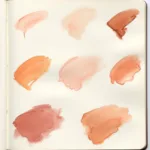Food coloring is often added to human food to make it more appealing, but is it safe for our canine companions? Many pet owners wonder about the potential dangers of food dyes for their furry friends. This article will explore the question, “Is Food Coloring Bad For Dogs?”, providing a comprehensive guide to help you make informed decisions about your dog’s diet.
Understanding Food Coloring and Its Effects on Dogs
Artificial food dyes are synthetic chemicals used to enhance the color of various food products. While generally considered safe for human consumption in regulated amounts, the effects on dogs can be different. Some dogs may experience allergic reactions or sensitivities to certain food dyes, manifesting as skin irritations, digestive upset, or even behavioral changes.
It’s important to note that not all food coloring is created equal. Some dyes, particularly those derived from natural sources like fruits and vegetables, are less likely to cause issues for dogs. However, artificial dyes, especially Red 40, Yellow 5, and Yellow 6, have been linked to adverse reactions in some pets. These dyes are commonly found in processed dog treats, commercial dog food, and even some homemade treats.
Identifying Food Dye Allergies in Dogs
If your dog consumes something containing food coloring and exhibits symptoms like itching, hives, vomiting, diarrhea, or hyperactivity, it’s possible they are experiencing an allergic reaction. While not all reactions are severe, it’s crucial to consult a veterinarian to rule out other potential causes and get appropriate treatment.
Identifying the specific dye causing the reaction can be challenging. An elimination diet, where specific ingredients are removed and reintroduced one by one, can help pinpoint the culprit. Working closely with your vet is essential in this process.
Safe Alternatives to Artificial Food Dyes
Fortunately, there are safe and natural alternatives to artificial food dyes that you can use when making homemade dog treats or choosing commercially available products. Natural colorings derived from fruits, vegetables, and spices, such as turmeric, beetroot, and spinach, can add vibrant hues to food without the potential risks associated with synthetic dyes.
For commercially available dog food and treats, always check the ingredient list. Look for products that use natural colorings or avoid those containing artificial dyes altogether. Many high-quality brands now offer dye-free options, catering to the growing demand for healthier pet food. Similar to is food coloring safe for dogs to eat, ensuring the safety of dog food is paramount.
What Colors are Particularly Harmful to Dogs?
While any artificial food coloring can potentially trigger a reaction in sensitive dogs, some colors, notably Red 40, Yellow 5, and Yellow 6, have been implicated in more adverse reactions than others. These dyes are commonly used in processed foods and treats, making it important to read labels carefully.
Can I Use Food Coloring for Tie Dye with My Dog Around?
While using food coloring for tie-dye, ensure your dog is kept away from the area to prevent accidental ingestion. Even though small amounts might not be immediately harmful, it’s best to err on the side of caution. Like with can you use food color for tie dye, precautions are necessary when handling dyes around pets.
What if My Dog Ingests a Small Amount of Food Coloring?
If your dog accidentally ingests a small amount of food coloring, monitor them closely for any unusual symptoms. In most cases, a small amount is unlikely to cause significant harm. However, if you notice any signs of distress, such as vomiting, diarrhea, or changes in behavior, contact your veterinarian immediately. Just like knowing what color is bad oil is important for engine health, understanding the effects of substances on dogs is crucial for their wellbeing.
Conclusion
While not all food coloring is inherently bad for dogs, artificial dyes pose potential risks, including allergic reactions and sensitivities. Opting for natural food colorings or dye-free options is always the safer choice. By carefully reading labels and understanding the potential risks associated with food dyes, you can ensure your furry friend enjoys a healthy and colorful life, free from the potential harms of artificial food colorings.
FAQ
- Are all food dyes bad for dogs? No, natural food dyes are generally safe. Artificial dyes are the primary concern.
- What are the symptoms of a food dye allergy in dogs? Symptoms can include itching, hives, vomiting, diarrhea, and hyperactivity.
- How can I identify the specific food dye causing a reaction? An elimination diet, guided by your veterinarian, can help pinpoint the culprit.
- What are some safe alternatives to artificial food dyes? Natural options include turmeric, beetroot, and spinach.
- What should I do if my dog ingests a small amount of food coloring? Monitor them closely for any unusual symptoms and contact your veterinarian if needed.
- Are there any dog treats that are free of artificial dyes? Yes, many high-quality brands offer dye-free treats.
- Can food coloring affect my dog’s behavior? In some cases, food dyes can trigger hyperactivity or other behavioral changes.
Need assistance? Contact us at Phone Number: 0373298888, Email: [email protected] or visit us at 86 Cau Giay, Hanoi. We have a 24/7 customer support team.
